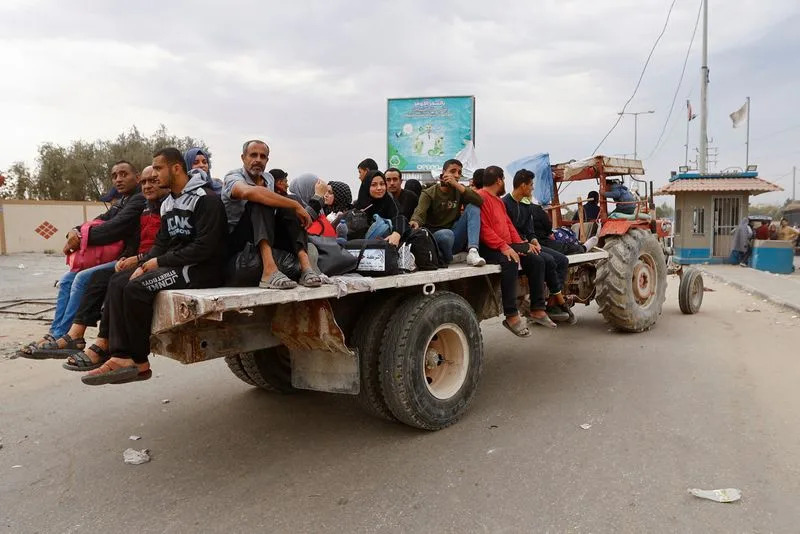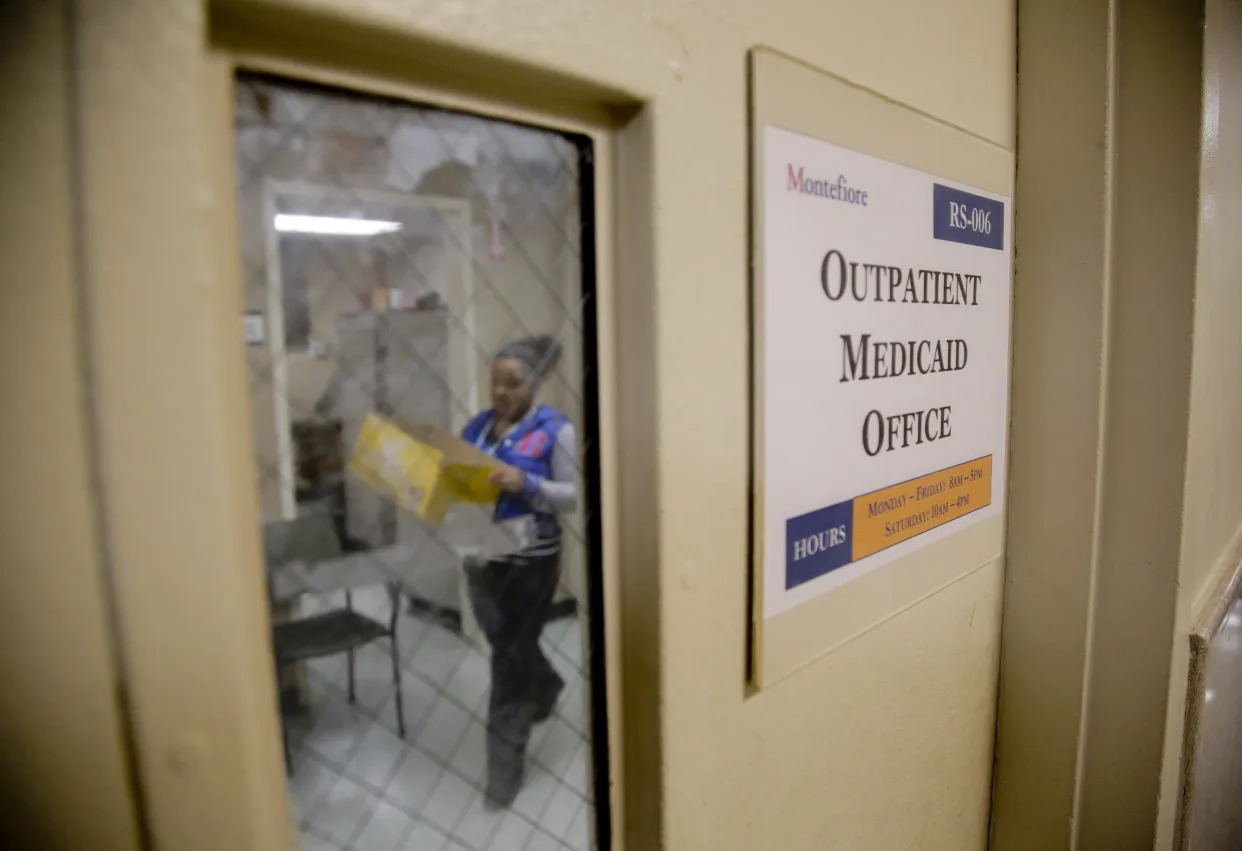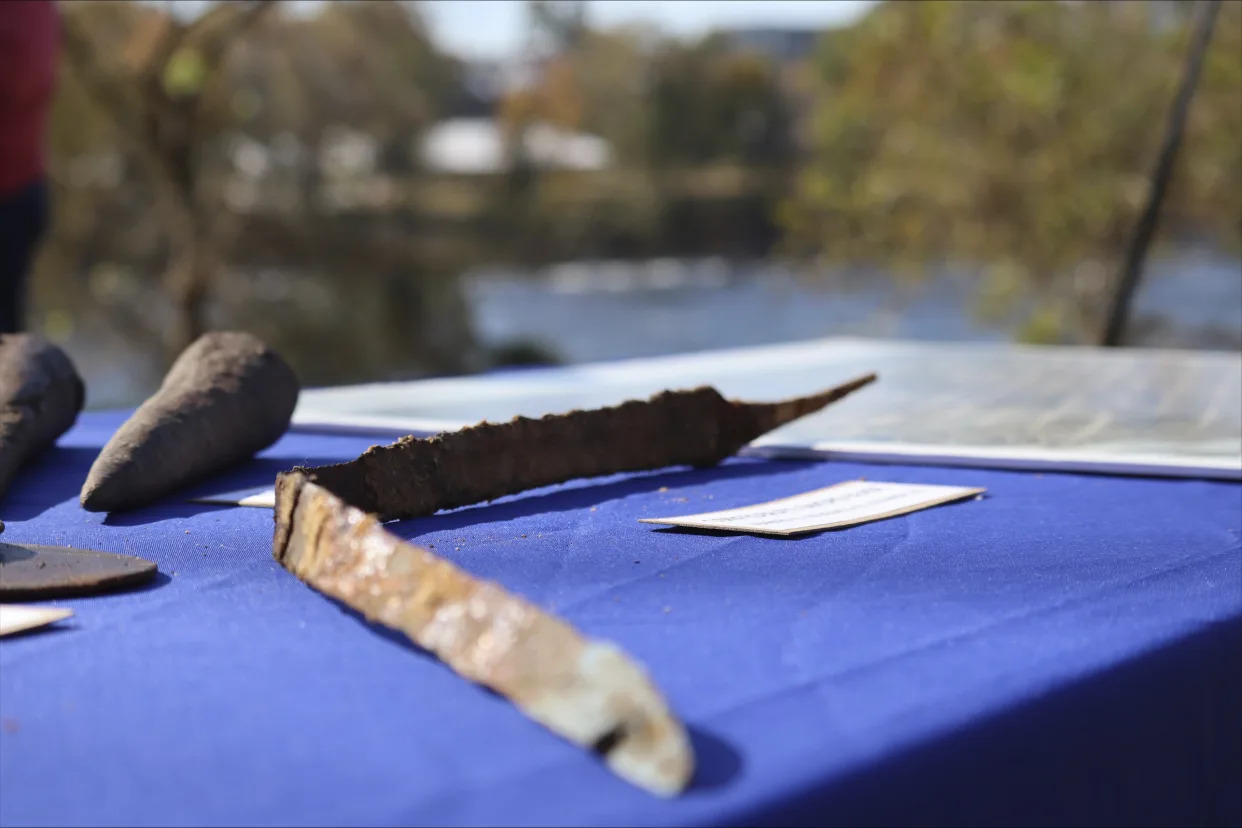Tue, November 14, 2023

Palestinians fleeing north Gaza move southward, in the central Gaza Strip
JERUSALEM (Reuters) - A senior far-right member of Israeli Prime Minister Benjamin Netanyahu's government said on Tuesday Gaza could not survive as an independent entity and it would be better for Palestinians there to leave for other countries.
Finance Minister Bezalel Smotrich, who heads one of the religious nationalist parties in Netanyahu's coalition, said he supported a call by two members of the Israeli parliament who wrote in a Wall Street Journal editorial that Western countries should accept Gazan families who expressed a desire to relocate.
The comments underscore fears in much of the Arab world that Israel wants to drive Palestinians out of land where they want to build a future state, repeating the mass dispossession of Palestinians when Israel was created in 1948.
"I welcome the initiative of the voluntary emigration of Gaza Arabs to countries around the world," Smotrich said in a statement. "This is the right humanitarian solution for the residents of Gaza and the entire region after 75 years of refugees, poverty and danger."
He said an area as small as the Gaza Strip without natural resources could not survive alone, and added: "The State of Israel will no longer be able to accept the existence of an independent entity in Gaza".
Smotrich spoke during Israel's invasion of the Gaza Strip, a blockaded coastal enclave ruled by the Islamist movement Hamas that is home to some 2.3 million people, most of them refugees after earlier wars.
Palestinians and leaders of Arab countries have accused Israel of seeking a new "Nakba" (catastrophe), the name given to the displacement of hundreds of thousands of Palestinians who fled or were driven from their homes in the wake of the 1948 war that accompanied the founding of the state of Israel.
Most ended up in neighbouring Arab states, and Arab leaders have said any latter-day move to displace Palestinians would be unacceptable.
Israel launched the Gaza operation in retaliation for the Oct. 7 attack by Hamas gunmen who burst out of the enclave and stormed across a string of communities in southern Israel, killing some 1,200 people and taking around 240 as hostages back into Gaza, according to Israeli official figures. Israeli leaders have vowed to destroy Hamas and rescue the hostages.
More than 11,000 Palestinians have been killed during the weeks-long Israeli bombardment of Gaza, according to Palestinian health authorities, and whole stretches of the enclave have been levelled or turned to rubble.
The Israeli military has told residents of northern Gaza to leave their homes and head to the southern end of the Strip, where it said they would be safer, and said they would be able to return once the situation is stabilised.
Israel withdrew its military and settlers from Gaza in 2005 after a 38-year occupation, and Netanyahu has said it does not intend to maintain a permanent presence again, but that Israel would maintain security control for an indefinite period.
However there has been little clarity about Israel's longer term intentions, and countries including the United States have said that Gaza should be governed by Palestinians.
(Reporting by James Mackenzie; editing by Mark Heinrich
Sanjana Karanth
Sun, November 12, 2023
An Israeli cabinet official has publicly admitted to the government’s ethnic cleansing of Palestinians, saying on television over the weekend that the country is “rolling out the Gaza Nakba.”
On Saturday, security cabinet member and Agriculture Minister Avi Dichter sat for a television interview with an Israeli news network. Dichter is part of the right-wing nationalist Likud party, which Prime Minister Benjamin Netanyahu chairs.
“We are now rolling out the Gaza Nakba,” Dichter said when asked if the recent images of northern Gaza residents evacuating south are comparable to images of the 1948 Nakba.
“From an operational point of view, there is no way to wage a war ― as the IDF seeks to do in Gaza ― with masses between the tanks and the soldiers,” he continued, according to a translation of the interview by Haaretz.
The Nakba, which in Arabic means “catastrophe,” refers to the mass displacement and ethnic cleansing of Palestinians during the 1948 Arab-Israeli war. Palestine was considered a multi-ethnic society until the tension between Arab and Jewish people rose as a result of both Jews migrating to flee persecution in Europe, as well as the Zionist movement attempting to establish a Jewish ethnostate in Palestine.
The tension escalated to war in 1948 after the UN General Assembly’s resolution trying to partition Palestine into two states was rejected a year earlier. The war resulted in the permanent displacement of hundreds of thousands of Palestinians by the newly formed Israeli forces.
Despite the UN calling for Palestinian refugee return and property restitution, Israel has continued to deny the rights of Palestinians and carry out an apartheid for 75 years. The anniversary of the Nakba serves as a painful acknowledgment of the generational and ongoing trauma that Palestinians face both on their occupied land and outside the region.
“Gaza Nakba 2023,” Dichter said. “That’s how it’ll end.”
When later asked if labeling the current forced evacuation a Nakba means Palestinians won’t be able to return to Gaza City, Dichter said: “I don’t know how it’ll end up happening since Gaza City is one-third of the Strip ― half the land’s population but a third of the territory.”
Israel’s monthlong siege on Gaza has killed more than 11,000 people and displaced millions. Israeli forces told Palestinians to evacuate northern Gaza to avoid being killed, though several areas in the southern region have also been bombed.
On Friday, Netanyahu said that he wants “full security control” of Gaza with the power to “enter whenever we want” to kill who Israel perceives to be enemies.
Sanjana Karanth
Updated Mon, November 13, 2023
Israeli Prime Minister Benjamin Netanyahu said on Sunday that Palestinian civilians being killed en masse are simply “collateral damage” in his military’s destruction of Gaza.
The right-wing leader appeared on multiple cable news shows to speak on the current state Israel’s monthlong siege on Gaza, which human rights experts have warned amount to ethnic cleansing and war crimes. For much of his appearances, Netanyahu attempted to downplay both his responsibility in the deadly Oct. 7 attack on Israelis as well as his military’s role in killing Palestinians.
More than 11,100 Palestinians, most of them women and children, have been killed since Israel’s violence escalated on Oct. 7, according to the Gaza Health Ministry. Thousands are still trapped under the rubble of destroyed buildings and homes, and millions are displaced and being forced to reside in Gaza refugee camps that are also being bombed by Israel. Many of the dead also include aid workers, journalists and doctors.
In Israel, the death toll stands at more than 1,200, most of whom were killed in the Oct. 7 attack by Hamas. The U.S. believes that the number of hostages taken by Hamas militants during the attack is in the hundreds.
On Friday, UN High Commissioner for Human Rights Volker Türk accused both Israel and Hamas of war crimes, and said that the only solution to the violence is to end the Israeli occupation and allow Palestinians the right to self-determination.
“The extensive Israeli bombardment of Gaza, including the use of high impact explosive weapons in densely populated areas, razing tens of thousands of buildings to the ground, is clearly having a devastating humanitarian and human rights impact,” he said. “After four weeks of bombardment and shelling by Israeli forces in Gaza, the indiscriminate effects of such weapons in a densely populated area is clear. Israel must immediately end the use of such methods and means of warfare, and the attacks must be investigated.”
“Considering the predictable high level of civilian casualty and the wide scale of destruction of civilian objects we have very serious concerns that these amount to disproportionate attacks in breach of international humanitarian law.”
“We’re deliberately doing everything in our power to target the terrorists,” Netanyahu told NBC’s “Meet the Press.” “And the civilians, as happens in every legitimate war, are sometimes what are called ‘collateral damage.’ That’s a longer way of saying unintended casualties.”
Israel’s ground forces battled Hamas militants near Gaza’s largest hospital, Al Shifa, where health officials say thousands of medics, patients and displaced families seeking shelter are trapped with no electricity and lack of medical supplies. Israel has accused Hamas of hiding in the hospital without providing evidence, but Hamas and hospital staff have both denied the allegations.
“Some hospitals, including Al Quds and Al Shifa hospitals, have also received specific evacuation orders, in addition to the general evacuation orders to all of northern residents of Gaza. But such evacuation, as the World Health Organization has warned, is a ‘death sentence’ in a context where the entire medical system is collapsing and hospitals in southern Gaza have no capacity to absorb more patients,” Türk said.
“While bombings on Gaza from air, land and sea continue, the complete siege now lasting over one month has made it an agony for residents in Gaza to find basic necessities, and frankly to survive,” he said. “All forms of collective punishment must come to an end.”
According to the Gaza Health Ministry, al-Shifa’s last generator ran out of fuel on Saturday, resulting in the deaths of three premature babies and four other patients. Ministry spokesman Ashraf al-Qudra said that 37 other children may be on the verge of death after the life support machines stopped working in the hospital’s neonatal intensive care unit.
Netanyahu claimed that Israel would help evacuate patients from the hospital. But in a statement obtained by Palestinian news agency WAFA, Palestinian Minister of Health Mai al-Kaila said that Israeli forces “are not evacuating people from hospitals; instead they are forcibly evicting the wounded onto the streets, leaving them to face inevitable death.”
Medical Aid for Palestinians, a United Kingdom-based humanitarian group, said it is concerned that more babies at al-Shifa Hospital’s neonatal intensive care unit will soon die. The organization also called out news outlets who are failing to verify Israel’s claims about its bombardment.
“We are deeply concerned by uncritical media reporting regarding the Israeli military’s statement that it will help move premature babies trapped at the hospital to a ‘safer hospital,’” MAP CEO Melanie Ward wrote. “The only safe option to save these babies would be for Israel to cease its assault and besiegement of al-Shifa, to allow fuel to reach the hospital, and to ensure the surviving parents of these babies can be reunited with them.”










